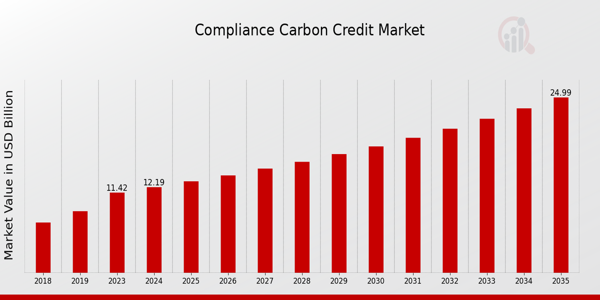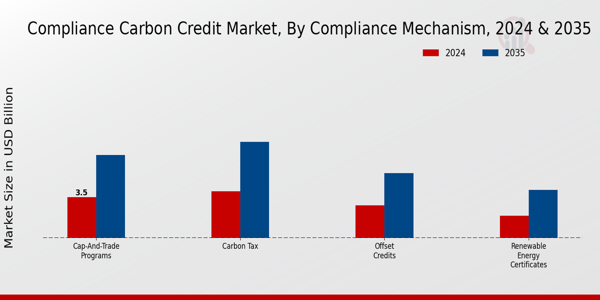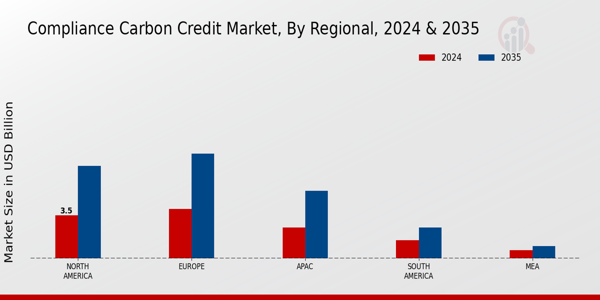Compliance Carbon Credit Market Overview
As per MRFR analysis, the Compliance Carbon Credit Market Size was estimated at 11.42 (USD Billion) in 2023. The Compliance Carbon Credit Market Industry is expected to grow from 12.19(USD Billion) in 2024 to 25.0 (USD Billion) by 2035. The Compliance Carbon Credit Market CAGR (growth rate) is expected to be around 6.74% during the forecast period (2025 - 2035).
Key Compliance Carbon Credit Market Trends Highlighted
The Compliance Carbon Credit Market is in the process of making some significant changes due to certain factors. First, global regulatory requirements are making it mandatory for companies to engage in environmentally friendly activities, which has resulted in a strong market for readily available carbon credits. As concern regarding climate change and the reduction of commercial and consumer greenhouse gas emissions grows, investments in initiatives aimed at reducing carbon footprints expand. Achieving a higher reputation and setting sustainability targets is also a major factor propelling par propulsion towards sustainability, which likely results in carbon target operational activities being adopted. The compliance carbon credit market has various branches that could be leveraged to maximize engagements.
As more countries put in place carbon pricing and cap-and-trade measures, companies can start applying those strategies to develop innovative and clean technologies that create carbon credits. Strengthening certification procedures and creating uniform standards to ensure transparency in the market is one of the trend drivers of increasing interaction between the public and private sectors. Also, new markets offer new opportunities. More investment in carbon credit projects translates to growth in environment-friendly ventures. Blockchain and digital platforms are giving credibility to carbon credit transactions by fostering transparency and tracking, therefore leading to the changes.
Because of the growing appreciation for the carbon-absorbing capacity of reforestation and sustainable land management practices, the emphasis on nature-based solutions is increasing. Accelerating change in perspective is towards a more systemic view of sustainability, where carbon credits can be embraced as a component of environmental, social and governance frameworks. Investors are starting to retreat from thinking of carbon credits as just compliance requirements; rather, they see them as assets that can add to competitiveness and increase value over time. Changes such as these are responsible for shaping the future trends of the Compliance Carbon Credit Market, thus making it important for the players involved to adjust to these changes.

Compliance Carbon Credit Market Drivers
Increasing Regulatory Pressure on Emissions Reduction
As countries around the world acknowledge the pressing need to tackle climate change, regulatory measures have become more stringent regarding emissions reduction. Governments are implementing carbon pricing mechanisms and cap-and-trade programs, fostering a more robust need for organizations to purchase carbon credits. This regulatory landscape not only encourages corporations to adopt cleaner practices but also promotes investment in renewable energy and technology innovations aimed at reducing greenhouse gas emissions.Additionally, international agreements, such as the Paris Agreement, set ambitious targets for emission reductions, which bolster the demand for compliance carbon credits. The Compliance Carbon Credit Market Industry is thus witnessing stronger growth fueled by these proactive policies aimed at mitigating climate change and creating a sustained market for carbon credits. The dynamic interplay between corporate responsibility and government initiatives leads to a compelling narrative in the carbon markets, allowing organizations that actively participate in these frameworks to enhance their reputational value while meeting compliance requirements.In response to these changes, many firms are strategizing to integrate sustainability into their operational models, thereby investing in credits that support international climate goals and ensure compliance with evolving regulations. The cumulative effect of such initiatives strengthens market traction, ensuring that stakeholders are increasingly investing in compliance carbon credits as a primary channel for achieving long-term sustainability objectives.
Growing Corporate Sustainability Initiatives
Corporations around the globe are increasingly prioritizing sustainability as part of their core strategies. This shift is fueling demand within the Compliance Carbon Credit Market Industry, as companies are willing to invest in carbon credits to offset their emissions. As stakeholders, including investors and consumers, advocate for greener practices, businesses are aligning their operational decisions with sustainable goals. The concept of corporate social responsibility is now deeply rooted in business practices, often translating into purchasing carbon credits as a commitment to reducing their environmental footprint.These sustainability initiatives, motivated by the desire to build brand equity and comply with market trends, play a critical role in enhancing market growth.
Technological Advancements in Carbon Credit Trading Platforms
The emergence of technological solutions has revolutionized the way carbon credits are traded. Advanced technologies, such as blockchain and artificial intelligence, are being adopted to improve transparency, efficiency, and accessibility within the Compliance Carbon Credit Market Industry. By streamlining the trading process, these technologies enable a wider range of participants to engage in the market, thus driving more significant activity and liquidity.The result is a more dynamic market environment that fosters competition and innovation.
Compliance Carbon Credit Market Segment Insights
Compliance Carbon Credit Market Compliance Mechanism Insights
The Compliance Mechanism segment of the Compliance Carbon Credit Market represents a critical area focused on regulating emissions and promoting sustainable practices across various industries. In 2024, the Compliance Mechanism is projected to form a significant part of the overall market, which is valued at USD 12.19 billion. Within this segment, the Cap-and-Trade Programs are particularly noteworthy, holding a market value of USD 3.5 billion in 2024 and expected to grow to USD 7.1 billion by 2035, showcasing its influential role in controlling and reducing carbon emissions through established limits and trading of allowances.In parallel, the Carbon Tax sub-segment demonstrates robust growth, with a valuation of USD 4.0 billion in 2024 and advancing to USD 8.25 billion in 2035, highlighting its importance as a fiscal policy approach designed to incentivize lower emissions by imposing direct costs on carbon output. Offset Credits also play a pivotal role in the Compliance Mechanism market, valued at USD 2.8 billion in 2024 and anticipated to reach USD 5.55 billion in 2035, allowing entities to purchase credits for emissions reduction projects, thereby stimulating investment in sustainable initiatives.Likewise, Renewable Energy Certificates generate value through their ability to validate and promote clean energy production, currently valued at USD 1.89 billion in 2024 and expected to expand to USD 4.1 billion by 2035, underscoring their significance in supporting renewable energy sources and their contribution to overall compliance efforts in reducing carbon footprints. The market growth can be attributed to the increasing regulatory pressures, global climate change initiatives, and a shift towards more sustainable business practices, while challenges such as regulatory complexity and market fluctuations present hurdles that must be navigated.With these dynamics, the Compliance Mechanism segment serves as a foundational pillar in the Compliance Carbon Credit Market, driving growth and fostering an environment conducive to investment in sustainable technologies and practices. The data derived from this sector reflects the ongoing evolution of compliance strategies aimed at combating climate change, reinforcing the demand for innovative solutions and systemic changes across industries.

Compliance Carbon Credit Market End User Insights
The Compliance Carbon Credit Market has been experiencing notable growth, with expectations of reaching a valuation of approximately 12.19 billion USD by 2024. The End User segment plays a critical role in this market, encompassing various industries, including Energy, Manufacturing, Transportation, and Agriculture. The Energy Sector holds a significant position as it strives to reduce carbon emissions by implementing greener practices, thus driving demand for carbon credits. The Manufacturing Industry follows closely as companies seek to comply with regulations while improving sustainability, leading to an increased market presence.In the Transportation Sector, the push for electrification and improvements in fuel efficiency intensifies the need for carbon credits as firms increasingly commit to lowering their carbon footprints. Agriculture, often seen as a major contributor to emissions, is also adapting by integrating sustainable farming practices, which necessitate the acquisition of compliance credits to offset their environmental impact. Overall, the evolving regulations and sustainability objectives across these sectors are shaping the landscape of the Compliance Carbon Credit Market, promising a robust growth trajectory in the coming years.
Compliance Carbon Credit Market Carbon Credit Type Insights
The Compliance Carbon Credit Market has been experiencing notable growth, with a valuation of 12.19 USD Billion in 2024. The Carbon Credit Type segment plays a crucial role in this market, consisting primarily of Verified Carbon Standard Credits, Gold Standard Credits, and Compliance Market Credits. Each of these types holds significant importance in the overall market landscape. Verified Carbon Standard Credits are widely recognized for their rigorous methodology in verifying emissions reductions, which enhances their credibility among stakeholders.Gold Standard Credits focuses on projects with sustainable development benefits, appealing to environmentally conscious investors. Compliance Market Credits serve regulatory requirements and are essential for companies aiming to meet emission reduction targets set by governments. The interplay between these credit types showcases a diverse approach to carbon trading, catering to various market demands and regulatory frameworks. With continuous advancements in regulatory measures and the increasing emphasis on sustainability, the segment's importance is likely to grow, driving further market growth and expansion.The market data indicates that this segment will significantly influence the overall performance and dynamics of the Compliance Carbon Credit Market industry.
Compliance Carbon Credit Market Regulatory Body Insights
The Regulatory Body segment of the Compliance Carbon Credit Market plays a crucial role, encompassing various entities such as Government Agencies, International Organizations, and Non-Governmental Organizations. By 2024, the overall market will be valued at 12.19 billion USD, highlighting a growing focus on compliance in carbon credit trading. Government Agencies are instrumental in establishing and enforcing regulations that govern carbon credit transactions, ensuring that emissions reduction targets are met. International Organizations, on the other hand, facilitate global cooperation and standardization among countries, driving adoption and compliance across borders.Non-Governmental Organizations contribute by raising awareness and advocating for environmental policies, influencing regulatory frameworks. The dynamics among these entities illustrate a robust structure critical for the market's growth. Growth drivers include stricter environmental regulations and increasing corporate responsibility towards sustainability, while challenges such as regulatory inconsistencies and market volatility persist. Opportunities arise in developing new compliance frameworks and enhancing reporting mechanisms, positioning the Regulatory Body segment as a significant component within the Compliance Carbon Credit Market industry, steering both market growth and robust compliance efforts.
Compliance Carbon Credit Market Regional Insights
The Compliance Carbon Credit Market, with a significant overall valuation of 12.19 USD Billion in 2024, showcases diverse regional dynamics that play a critical role in market growth. North America holds a major share, valued at 3.5 USD Billion, driven by established regulatory frameworks and corporate sustainability initiatives, and is expected to grow to 7.5 USD Billion by 2035. Europe follows closely, with a valuation of 4.0 USD Billion in 2024, attributed to ambitious climate goals and strict emissions regulations, escalating to 8.5 USD Billion by 2035, marking it as a dominant player.The APAC region, valued at 2.5 USD Billion in 2024, reflects emerging market potential with ongoing environmental policies, projected to reach 5.5 USD Billion in 2035. South America, with a valuation of 1.5 USD Billion in 2024, signifies growing awareness and initiatives; however, it maintains a smaller footprint in the overall market, potentially achieving 2.5 USD Billion by 2035. Lastly, the MEA region, valued at 0.69 USD Billion in 2024, is in nascent stages yet represents opportunities for future expansion, expected to reach 1.0 USD Billion by 2035.These statistics reflect the varied growth drivers, market trends, opportunities, and challenges each region faces within the Compliance Carbon Credit Market.
Compliance Carbon Credit Market Key Players and Competitive Insights
The Compliance Carbon Credit Market has been experiencing significant growth driven by the increasing awareness of climate change and the need for organizations to adhere to regulatory frameworks aimed at managing carbon emissions. This market involves various stakeholders such as governments, corporations, and environmental organizations that are engaged in the trading of carbon credits to offset their greenhouse gas emissions. As these entities are required to meet specific targets, the competition within the market is becoming increasingly dynamic. Entities are focusing on innovative strategies, including technology advancements, sustainable practices, and partnerships, to navigate the complexities of compliance and meet regional standards. The landscape is further complicated by diverse regulatory environments across regions, prompting companies to ensure they are equipped to manage compliance effectively while maximizing their market share.Caroil is well-positioned within the Compliance Carbon Credit Market, leveraging its strong operational capabilities and extensive industry experience. The company has built a robust framework for tracking emissions and generating credible carbon credits, which gives it a competitive edge. Its strengths lie in its ability to navigate the complexities of regulatory requirements while fostering relationships with various stakeholders. Caroil has invested in technology that enhances transparency and efficiency in emissions reporting, making it an attractive partner for organizations looking to reduce their carbon footprints. Furthermore, the company's commitment to sustainable practices resonates well with clients and investors who prioritize environmental responsibility, demonstrating that it understands the importance of aligning business practices with global sustainability goals.Verra has made significant strides in the Compliance Carbon Credit Market by emphasizing the importance of rigorous standards and methodologies for carbon credit generation. The company has established itself as a leader in developing and managing innovative solutions that facilitate the issuance and retirement of carbon credits, which reinforces its reputation within the market. Verra's strengths are evident in its credibility, as it maintains a strict verification process that enhances the integrity of the carbon credits created under its standards. This focus on quality places Verra in a strong position to attract compliance-driven entities that seek reliable and measurable carbon offsets. The robust framework that Verra provides not only aids organizations in meeting regulatory requirements but also supports their sustainability objectives, thereby solidifying its role as a key player in the competitive landscape of the compliance carbon credit market.
Key Companies in the Compliance Carbon Credit Market Include
- Caroil
- Verra
- Natural Capital Partners
- EcoAct
- Climate Impact Partners
- Gold Standard
- The Nature Conservancy
- Evergreen Carbon
- South Pole
- Carbon Credit Capital
- Sustainable Development Capital
- Natural Resources Defense Council
- Carbon Trust
Compliance Carbon Credit Market Industry Developments
Recent developments in the Compliance Carbon Credit Market have seen increased interest and participation from various stakeholders as countries globally amplify efforts to meet climate targets. Companies such as Verra and EcoAct are actively evolving their methodologies to enhance the verification processes of carbon credits, ensuring adherence to stringent compliance standards. The Nature Conservancy continues to advocate for innovative funding solutions to protect natural resources through carbon markets, increasing the urgency to address climate change. In terms of mergers and acquisitions, notable activity has been associated with South Pole, which is reportedly expanding its portfolio through strategic partnerships to enhance project offerings and global reach. Carbon Credit Capital has seen investments aimed at boosting its technological capabilities for better tracking and trading of carbon credits. Furthermore, the market valuation for firms such as Climate Impact Partners and Gold Standard is witnessing upward momentum, reflecting heightened demand for sustainable solutions. This growth signals a broader recognition of the necessity for compliance markets to facilitate the transition towards a low-carbon economy as corporate and regulatory pressures mount worldwide.
Compliance Carbon Credit Market Segmentation Insights
Compliance Carbon Credit Market Compliance Mechanism Outlook
- Cap-and-Trade Programs
- Carbon Tax
- Offset Credits
- Renewable Energy Certificates
Compliance Carbon Credit Market End User Outlook
- Energy Sector
- Manufacturing Industry
- Transportation Sector
- Agriculture
Compliance Carbon Credit Market Carbon Credit Type Outlook
- Verified Carbon Standard Credits
- Gold Standard Credits
- Compliance Market Credits
Compliance Carbon Credit Market Regulatory Body Outlook
- Government Agencies
- International Organizations
- Non-Governmental Organizations
Compliance Carbon Credit Market Regional Outlook
- North America
- Europe
- South America
- Asia Pacific
- Middle East and Africa
| Report Attribute/Metric |
Details |
| Market Size 2023 |
11.42(USD Billion) |
| Market Size 2024 |
12.19(USD Billion) |
| Market Size 2035 |
25.0(USD Billion) |
| Compound Annual Growth Rate (CAGR) |
6.74% (2025 - 2035) |
| Report Coverage |
Revenue Forecast, Competitive Landscape, Growth Factors, and Trends |
| Base Year |
2024 |
| Market Forecast Period |
2025 - 2035 |
| Historical Data |
2019 - 2024 |
| Market Forecast Units |
USD Billion |
| Key Companies Profiled |
Caroil, Verra, Natural Capital Partners, EcoAct, Climate Impact Partners, Gold Standard, The Nature Conservancy, Evergreen Carbon, South Pole, Carbon Credit Capital, Sustainable Development Capital, Natural Resources Defense Council, Carbon Trust |
| Segments Covered |
Compliance Mechanism, End User, Carbon Credit Type, Regulatory Body, Regional |
| Key Market Opportunities |
Increased regulatory frameworks, Expanding corporate sustainability initiatives, Innovative carbon offset technologies, Rising demand for carbon trading, Growing awareness of climate change impacts |
| Key Market Dynamics |
Regulatory frameworks and policies, Increasing corporate sustainability goals, Technological innovation and tracking, Growing awareness of climate change, Volatility in carbon credit prices |
| Countries Covered |
North America, Europe, APAC, South America, MEA |
Frequently Asked Questions (FAQ) :
The Compliance Carbon Credit Market is expected to be valued at 12.19 billion USD in 2024.
By the year 2035, the Compliance Carbon Credit Market is projected to reach a value of 25.0 billion USD.
The expected CAGR for the Compliance Carbon Credit Market from 2025 to 2035 is 6.74%.
In 2024, Europe is expected to hold the largest market share, valued at 4.0 billion USD.
North America is projected to reach a market value of 7.5 billion USD by 2035.
The major compliance mechanisms include Cap-and-Trade Programs, Carbon Tax, Offset Credits, and Renewable Energy Certificates.
Cap-and-Trade Programs are expected to be valued at 3.5 billion USD in 2024.
Key players in the market include Caroil, Verra, Natural Capital Partners, EcoAct, and Climate Impact Partners.
The market size for Offset Credits is expected to reach 5.55 billion USD by 2035.
Challenges include regulatory changes and market fluctuations that can affect carbon pricing and investment.

















